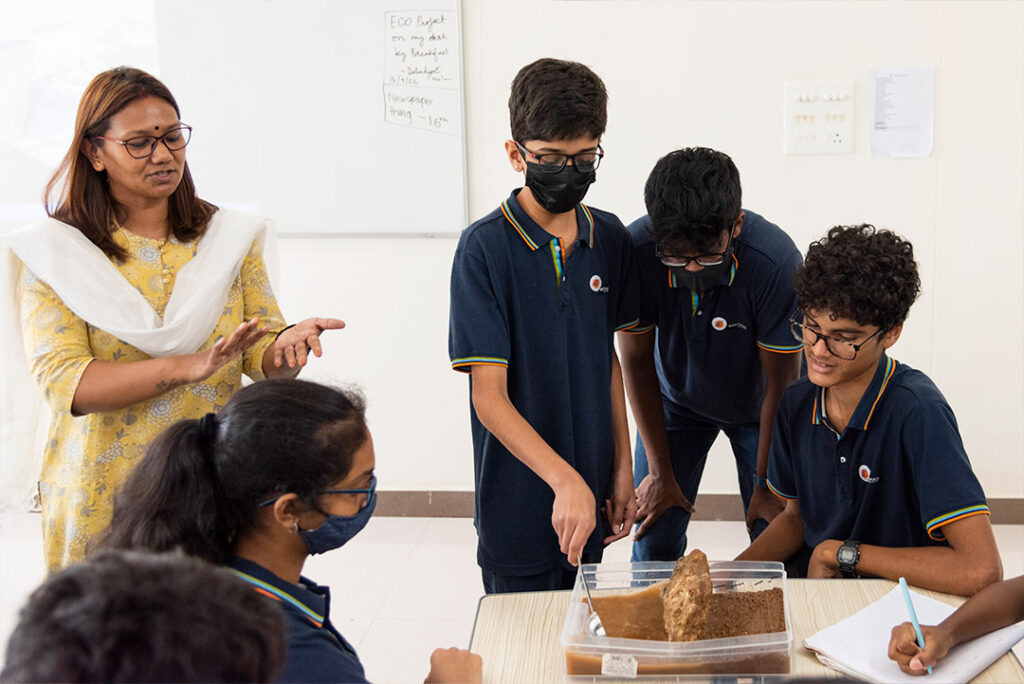
We have devised the basic framework for a holistic programme of education that focuses on creative talents, skills, aptitudes, and attitudes that helps children process and transform information into knowledge, and subsequently into wisdom that can be applied to everyday life.
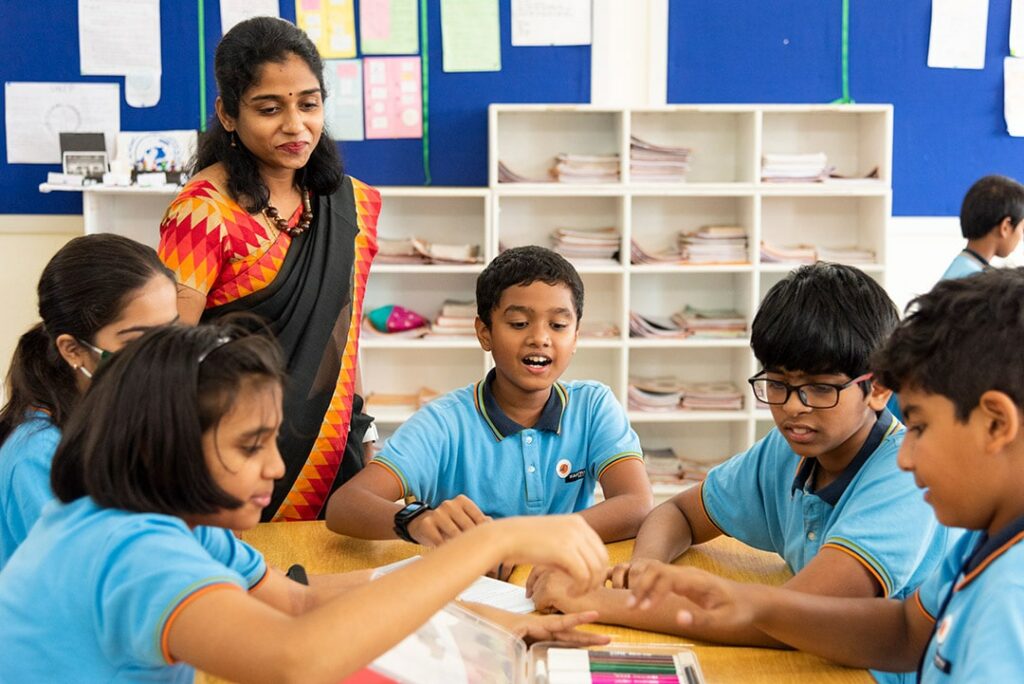
English
At Manthan, the English Language curriculum is planned and tailored for the learners, strictly adhering to the guidelines and recommendations made by Cambridge International Education. Our Curriculum Development Unit follows the Curriculum Framework and the Schemes of Work generated by Cambridge to design every unit for our learners meticulously.
We primarily focus on developing four core language skills:
- Reading
- Writing
- Speaking
- Listening
These language skills are introduced, developed, and reinforced at varied learning stages through a systematic, intensive, and well-investigated approach.
Reading is an essential and critical skill. We consider various reading strategies and approaches to develop reading skills in our learners.
In the primary stages, learners read for fun and phonic awareness (letter sounds, word patterns, rhyming words). However, as they progress to stages 5 to 8, they not only read for pleasure but also for explicit and implicit meaning and learn to use the techniques of skimming, scanning, and extensive reading.
Learners are encouraged to engage with books by exposing them to a strong reading culture so that the habit of reading can be developed during the formative years. For this, stage-wise reading lists are generated. A class novel is assigned for the learners to experience the characters’ pleasures, adventures, and successes together. Learners create reading corners in their classrooms and visit the library to explore a wide range of books and cultivate a disciplined reading habit, which significantly prepares them for creative expression, comprehending complex texts, and acquiring vocabulary.
In Stages 9-12, learners acquire more advanced reading skills. They learn to decode texts and read to explore how linguistic features interact with the readers to convey meanings and create the effects desired by the writer. They analyse and comment on language.
Writing to express: Our learners’ imaginative flights get documented in varied forms. A sound base for these expressions is formed by the units we teach. Learners explore and train to write various fiction and non-fiction text forms, ranging from short stories to poems to blogs, voiceovers, leaflets, travelogues, and chapter books. The list is endless. Every writing skill is carefully approached and developed.
While the early learning years focus on recognising letters, forming letters, and reading and spelling words correctly; the complexity of skills increases as students ascend their learning stages. Students begin to plan their texts, write in drafts, reflect on their writings, and proofread and edit their expressions. Step-by-step support is extended to all learners through sample texts, writing frames, and feedback from peers and teachers to help them refine their expressions.
By the time learners reach their High School years, they are well-versed in many forms of writing; and are set on learning more advanced and complex forms such as text analysis, essays, opinion texts, and commentaries on their written expressions.
Speaking and listening for effective communication
We believe that language is acquired through interaction; hence, our sessions are highly interactive. Students engage in multiple speaking and listening opportunities from the very early stages. They begin engaging in recitations, storytelling, and giving short presentations. As students progress to higher stages, they learn complex skills through speaking activities such as dramatization, simulation of chat shows, news reporting, podcast making, and compering, providing voiceovers for documentaries, expressing viewpoints in debate sessions, and giving feedback to peers.
Activity-based Learning
Our Curriculum Development Unit and passionate teachers design an array of activities and games to support learning in the classroom. For instance, to help learners remember the characters in a play, teachers use stick puppets, or games like hot seating and finger puppets to support learning. In more advanced levels, to teach the idea of voiceover, the learners are given the real-time experience of watching a documentary, making notes on the speaker’s voice, the content of the documentary, and then creating a script of a short documentary film. All in all, learning by doing is vital in our language programme.
Differentiated Learning
We understand that a class is a mix of multiple intelligence levels, and students learn differently. Considering this, we adopt strategies in our lessons to accommodate varied learner levels, be it kinaesthetic, visual, or auditory. Learning routines and active learning strategies are incorporated to call increased focus in classrooms. These may include routines like ‘Think, Pair, Share’, ‘Peer Feedback’, ‘Flip Learning’, ‘Recall, Repeat, Recycle’, ‘Sing Along’ and many more.
Remedial Support
Constant remedial support is offered to learners to match them to the expected skill sets. The gaps in learning and concepts are identified through a series of specialised assessments, following which necessary one-on-one, interactional or written guidance is extended to the learners.
Literary Culture
Students are given a strong literary culture in school. Our literary carnival ‘Literati’ lines up an array of literary events such as the Spell Bee, dramatization, story writing, poem writing, extempore, debating, declamation, monologues, slam poetry, comedy Knights, and further extends to media skills like photo stories and documentary making, to give them a fine exposure and insight into how language works in real life. Additionally, ‘Sparsh’, our school magazine and newsletter, is yet another fantastic medium where learners get an opportunity to publish their creative expressions and communicate their thoughts and views with each other as a student community.
To sum up, the approach we take towards developing language skills is intensive but, at the same time, fun, student-friendly and driven by real-time experience with the language.
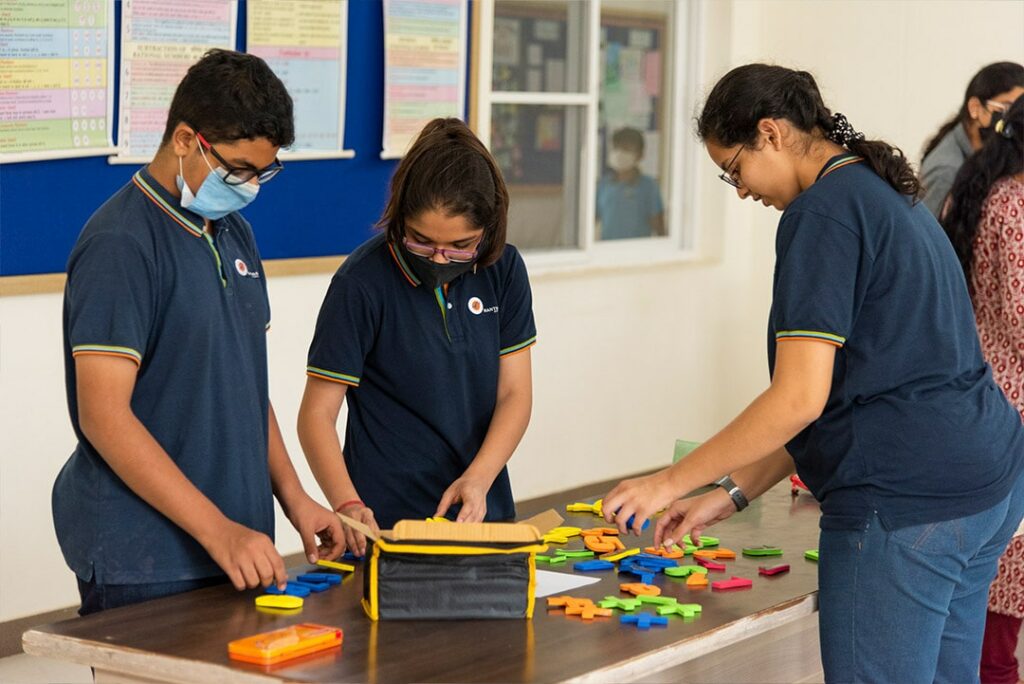
Mathematics
At Manthan, we place a strong emphasis on principles, patterns, systems, functions, and relationships so that students can apply their mathematical expertise and have a comprehensive understanding of the subject. We employ a variety of teaching methods to assist students in grasping concepts, engaging in the subject, and acquiring a variety of mathematical skills that will be useful to them in everyday life. Our wide range of tests evaluates students’ abilities, knowledge, and comprehension.
In Primary School
We follow the CPA model and the 5Es model of learning. CPA stands for Concrete, Pictorial and then Abstract. In the Concrete stage, the teacher begins instruction by modelling each mathematical concept with concrete materials (e.g. chips, cubes, base ten blocks, fraction bars etc.). In the Pictorial stage, the teacher transforms the concrete model into a representational (pictorial) level, which may involve drawing pictures; using circles, dots, bars, a number line, etc. The Abstract stage uses abstract symbols to model problems. At this stage, the teacher helps to develop the mathematical concept at a symbolic level, using numbers, notations, and mathematical symbols to represent the number algorithm. In this teaching process we apply 5E model which is constructivist in nature and includes five stages: engage, explore, explain, extend, and evaluate.
Each stage of instruction details the ideas, concepts, and skills needed for student inquiry at that level. In addition, there are expected behaviours for teachers and students, as well as opportunities to demonstrate learning through application.
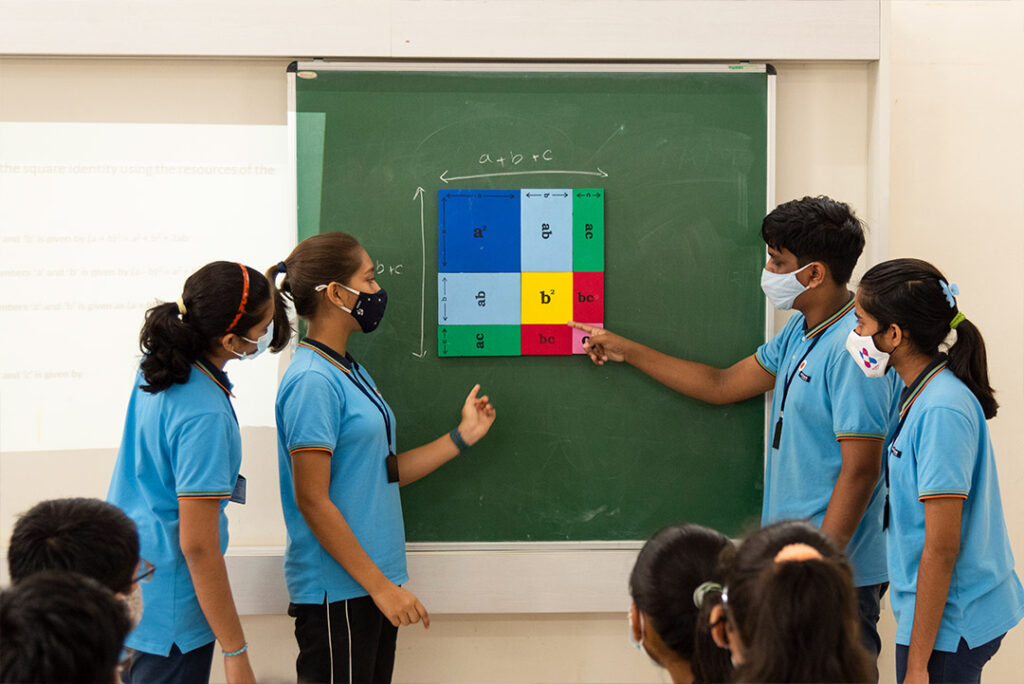
In Middle School and High School
Our approach is entirely inquiry-based, research-based and activity-based which involves learning by doing. Students of these groups engage themselves in various hands-on activities for the reinforcement of math concepts. A number of math lab resources like geoboard, integer counters, algebra tiles, etc. are used by students to prove properties of 2D shapes, solve linear equations, or practice operations in integers. Activities involving math resources aid clarity in concepts and facilitate active participation of kinaesthetic learners making it an enriching and enjoyable learning experience for all.
Our High School learners did a presentation to show how a body projected by external force continues in motion by its own inertia using concepts of parabolic path and quadratic equations. Students showed the trajectory path by taking examples such as javelin throw, and the firing of firearms, missiles, etc. used in the Russian-Ukrainian War. They used charts and posters to display the information about projectile motion, gravity impact on the object and derivation of formulae.
Another team presented Math concepts related to orbital velocity to calculate the speed that a particular object has to travel at in order to stay in the orbit of any celestial object. They also presented the orbital period which is the time taken for an object based on its speed and the circumference of the celestial object by using Math concepts such as radius, distance, orbital access, and gravity to derive a basic formula where we can switch the variables to get the correct value through a series of calculations.
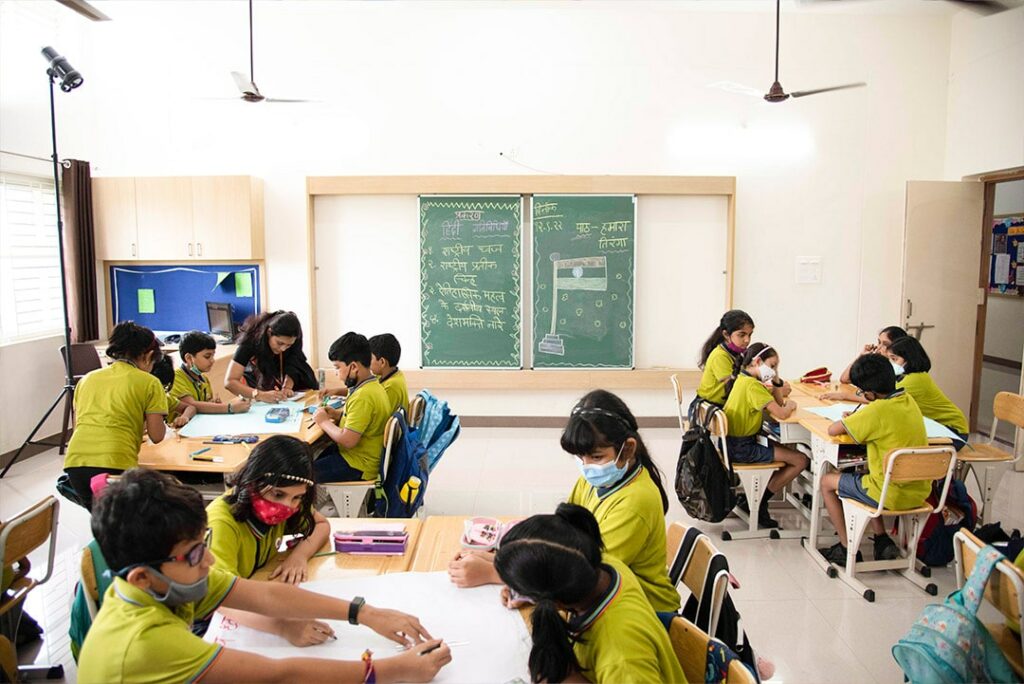
Second Language
‘Kos kos par badle pani, char kos par vani’
For a diverse country such as India, this popular saying is absolutely true. It means that if you travel, you will find that the language/dialect spoken changes every 4 miles! While this makes us a very rich nation of many languages, it also poses some unique problems. Teaching and learning a second/vernacular language, which is not widely spoken in the state, has its own challenges. At Manthan, Hindi, Telugu and French (from Grade 8) are offered as second language options.
We strongly believe that it is important to learn as many languages as one can during the early years. Research proves that learning a new language can be a useful tool in developing a child’s brain and can bring about improvements in memory, speech and sensory processing. Children are usually more capable of learning new words or phrases with the same ease as learning their native language. They absorb new information effortlessly and start using a new language confidently. Without conscious effort, they develop vital listening skills, which in turn, support speech and language development.
The biggest challenge in teaching a second language is learners’ minimal exposure to it beyond the classroom and even lesser usage of the same. A 40-minute session is never enough to explore, understand and then execute the nuances of a language. However, at Manthan, we accept this challenge with a lot of patience. Our key technique is to use different strategies and tools and a very gripping lesson plan for a productive 40-minute class. We use a lot of resources such as audio visual media; board games such as snakes and ladders using parts of speech (noun, pronoun, adjective, verb, etc.). We also conduct a lot of activities such as treasure hunt, recitation sessions (mushaayara), role play, story-telling, word wall for vocabulary, creative displays, and many more to keep the learners engaged and interested so that their thirst for learning is unwavering.
Our second language curriculum is distributed into 5 segments and each class segment follows a different teaching/learning module. Following Bloom’s Taxonomy, we gradually proceed from low order skills to high order skills, from knowledge and understanding to creative skills. In the early learning years the focus is on recognising letters, forming letters, and reading and spelling words correctly. The complexity of skills increases as learners progress to the next learning stage.
Grade 1
We introduce the new language in the form of the alphabet and small words to develop vocabulary. This creates a strong foundation for recognising and understanding the language. Exposure to the second language follows a very scientific approach of listening first, so that learners become comfortable hearing the new language and its syntax.
Grade 2
This foundation is strengthened further. The focus shifts to developing the four core language skills – listening, speaking, reading and writing.
Grades 3-5
These language skills are developed, and reinforced further to make them independent learners who can read, write, comprehend and speak confidently.
Grades 6-8
Learners are encouraged to explore additional language resources such as the library books and other reading material in order to develop proficiency in the language so that they can learn to express themselves clearly and can carry on a conversation on their own.
Grades 9-12
Learners are encouraged to explore their creative skills in the second language – both in speaking and writing. Speaking skills are enhanced in the form of activities such as debates, plays, etc. Writing skills are honed through composing essays, writing poems and short stories. Learners are often at their best in exhibiting their creative skills. We also teach them comprehension through CLOSE reading exercises (Check for unknown words, Look for key ideas, Observe text features, Study the structure of text and sentences, and Evaluate the inferences). All this training enriches their language skills and also allows them to approach board exams fearlessly.
Grammar
Grammar is taught in a very practical way through different prose and poetry units. In language learning, there is always a lot of scope for creativity and all our learners are always budding with new ideas. Additionally, we as teachers, channelise their ideas by giving them various platforms to exhibit their creativity ranging from giving them prompts or stem sentences to entirely leaving them on their own to express themselves freely, be it during the Language Week or in the school magazine.
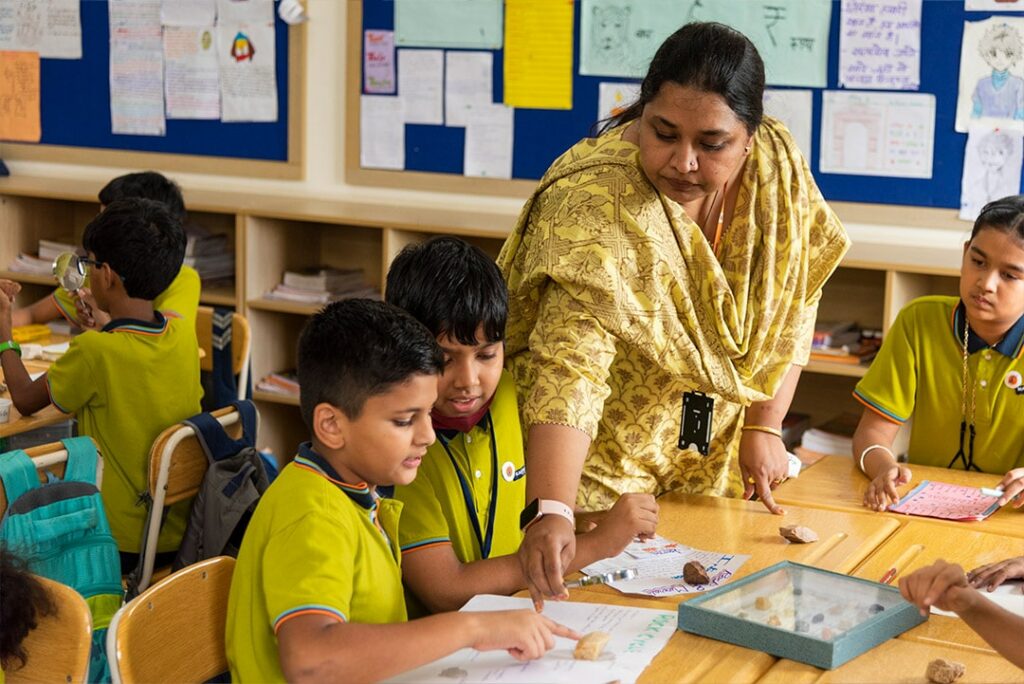
Science
At Manthan, we follow the “Spiral Curriculum” method proposed by Jerome Bruner. Spiral Curriculum refers to a curriculum design in which key concepts are presented repeatedly throughout the curriculum, but with deepening layers of complexity, or in different applications. It is a continuous learning process where new concepts are introduced to add new information around the current and past knowledge/experience. Students are encouraged to question and then find answers. We completely believe in the Albert Einstein motto- “The most important thing is to never stop questioning.” Over the school years, students are taught how to observe, how to gather information, and then how to analyse, predict, and present their conclusions or data, etc. A lot of emphasis is given on integrating different subjects and making the learners understand the significance of the same.
During Primary School years, importance is given to developing observation skills. Learners often go for nature walks in the school garden to observe plants, flowers, trees, grass, stones, soil, etc. Such activities help them develop their curiosity – a key to learning Science. These activities are followed by class room discussions so that there can be free exchange of ideas between learners under the supervision of the teacher. They are encouraged to speak about all related and unrelated information gathered during the activity and are then guided to discuss scientific properties such as colours, patterns, size, etc. This helps them to learn how to analyse and collate information in a structured manner to achieve the learning objective of the topic. Related worksheets are given to reinforce the learning.
As they become older, learners carry out hands-on activities and experiments to understand different scientific phenomena. They visit the science laboratories in the school for demonstrations. They learn to handle the apparatus there with confidence under teacher supervision so that they concurrently become aware of and follow laboratory safety precautions. They are trained to investigate and identify variables that may need to be changed or kept constant. They are encouraged to predict results and give suggestions which are then discussed and analysed with them so that they can develop skills to think of feasible and practical solutions. Students are often asked to create models (using recycled or easy to find materials) to showcase and present their understanding of different scientific processes. Rubrics are shared prior to such activities, and this methodology keeps learners engaged and proactive in the learning process.
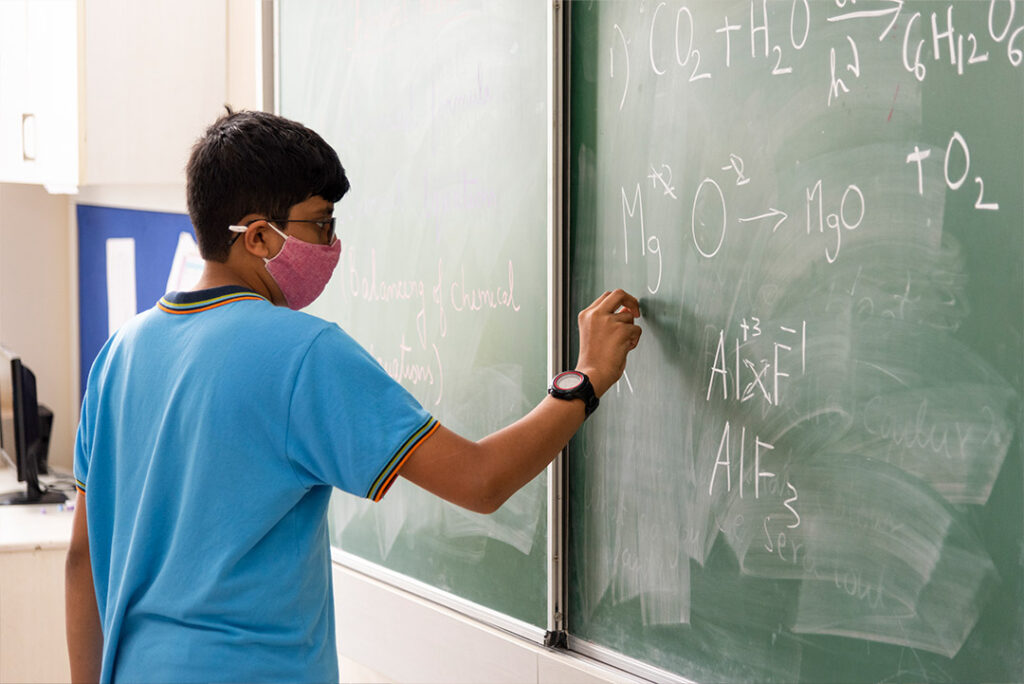
Middle School Science
Middle School Science is divided into Biology, Chemistry and Physics, and is then integrated with Earth Science. Subject specific teachers handle Middle School classes by adopting learner-centred methods such as individual activities, group projects/presentations, and at times, flipped learning. Tasks are allocated by teachers with complete awareness of the group dynamics, learner abilities, context and time frame. Most of the topics are taught using the elicitation method where discussions and question-answer sessions are based on prior knowledge. Students are given situations to analyse or probe and formulate. When the results are presented, the teacher clears all misconceptions and bridges the learning gaps. This allows teachers to know their students individually and guide them as needed. By the end of Middle School, learners are confident of experimenting in the laboratory and using apparatus. This helps them when they move to High School.
High School learners
High School learners are involved in discussion and peer learning. Teachers assign tasks with prior intimation so that learners come prepared to the class. They are encouraged to question, clear peer learners’ doubts, etc. Assessment techniques are introduced and implemented in classroom settings so that board exams can be handled without fear or stress. High school students are also actively involved in conducting Science Fairs to showcase their learning.
A few practices that are followed across grades and learning segments to enhance the learning experience are:
- Display videos on topics, as and when required, followed by a discussion or a quiz
- Apply methodologies that engage the learners, build curiosity and develop analytical skills
- Encourage class participation without fear of being incorrect with the objective of guiding students to the most appropriate answers
- Make learners conscious of their responsibilities towards ‘care for the environment’
- Engage learners in research, often on diverse topics proposed by the learners themselves
- Use multiple assessment modes to check the progress of learning
- Organise field trips (grade-wise) to strengthen learning
- Provide opportunities for experiential learning by associations with esteemed institutions such as NYAS, TIFR, CCMB, Dr Reddy’s Labs, etc.
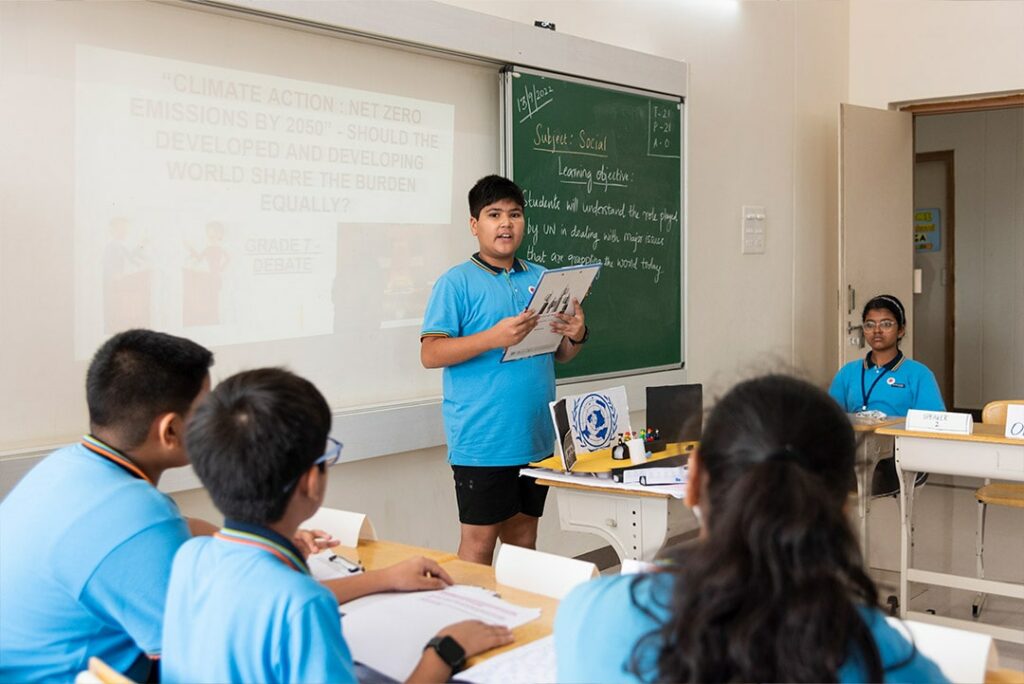
Social Studies
Social Studies is introduced to students in Grade 3 at Manthan. It is taught as a skills-based subject that focusses on students’ research, analytical, evaluation, and collaboration skills. With every topic and grade level, these skills are honed further and improved. True to its name, “Social Studies” makes students aware of their surroundings on both local and global levels so that they can develop into informed decision-makers in the future. Learners are required to undertake research, analyse events throughout the world, and present their findings in class as part of a variety of activities that are completed with each topic.
In Grade 3
Learners begin by studying their own surroundings – their state of domicile and its physical characteristics and terrains, demography, local culture, and its history. They examine the human geography of the state in which they live and determine whether there are any historical links. This knowledge is acquired through activities that involve working in groups and formulating questions based on the topics they are learning. They are encouraged to include adults (such as parents, teachers, neighbours, etc.), and their peers in these explorations in order to learn from them and then share the information in the class. They present their understanding in the forms of charts, posters, hoardings, etc. which are then displayed in the class. In subsequent years, these analytical skills are enhanced further. In Grade 4, students analyse the same elements on a larger scale as part of their study of the nation as a whole. They learn about Indian history and become familiar with its vibrant and varied culture that has sustained through centuries.
In higher grades
Exploration becomes worldwide when students start investigating world cultures. They discover the demographics and topography of different nations, and contrast them with India. This learning level, especially in middle school, places a strong emphasis on research skills. Students learn how to initiate topics, investigate their backgrounds, formulate questions, and gather information during the various phases of the research process. Under the direction of a teacher, they collaborate in groups and investigate every element. They choose their own theme, formulate questions they have always been curious about but have never found solutions to, and develop a much organised approach to it. This type of education has a significant positive effect on our students because they retain the concepts they learn through this approach and use this ability to comprehend the topics they study in other subjects as well.
High school students get the option to select from a wide range of Humanities courses such as Business Studies, Economics, Geography, and Global Perspectives, to mention a few. They engage in more in-depth conceptual examination and use their training over the years to take on and excel in various disciplines through case studies, discussions, debates, etc. Empathy is another key quality that Manthan teaches from early on. Students develop empathy for the people and their situations as a result of every activity they engage in during their social classes, whether it is role play, or research involving formulating a questionnaire and interviewing people at the school or in their community, or critically analysing a historical idea. They also learn to make educated decisions.
At Manthan
We firmly believe that one subject cannot be studied in isolation. It must be incorporated into the curriculum together with the other topics and other subjects. This process is also begun and monitored from Grade 3 onwards. At different stages, learners are trained to connect and relate with other subjects while learning Social Studies. The various skills of data analysis through graphical presentation show them how Math is linked. They often understand the concepts of Geography with the help of Science such as composition of rocks (Chemistry) or study of tectonic plates (Physics). They use their language skills to write creative texts to present their feelings and opinions. Technical skills acquired in ICT classes become critical when they present their understanding in the form of PowerPoint presentations or videos.
Every Social Studies activity is designed to make students think, analyse, and assess a certain aspect before reaching a clear conclusion. Discussions and debates are given a lot of value as evidence for such activities. Classes are planned to allow students to express their views and become knowledgeable and confident speakers. Primary, Middle, and High School debates are organised according to age levels, and students grow and learn how to listen to others and frame opinions in a group. They also learn to distinguish between fact and opinion and make informed decisions on their own. They begin to emphasise on building awareness and exploring to gain further information. Overall, the study of Social studies makes students knowledgeable, self-assured individuals who empathise with others and their surroundings and feel inclined to contribute back to society.
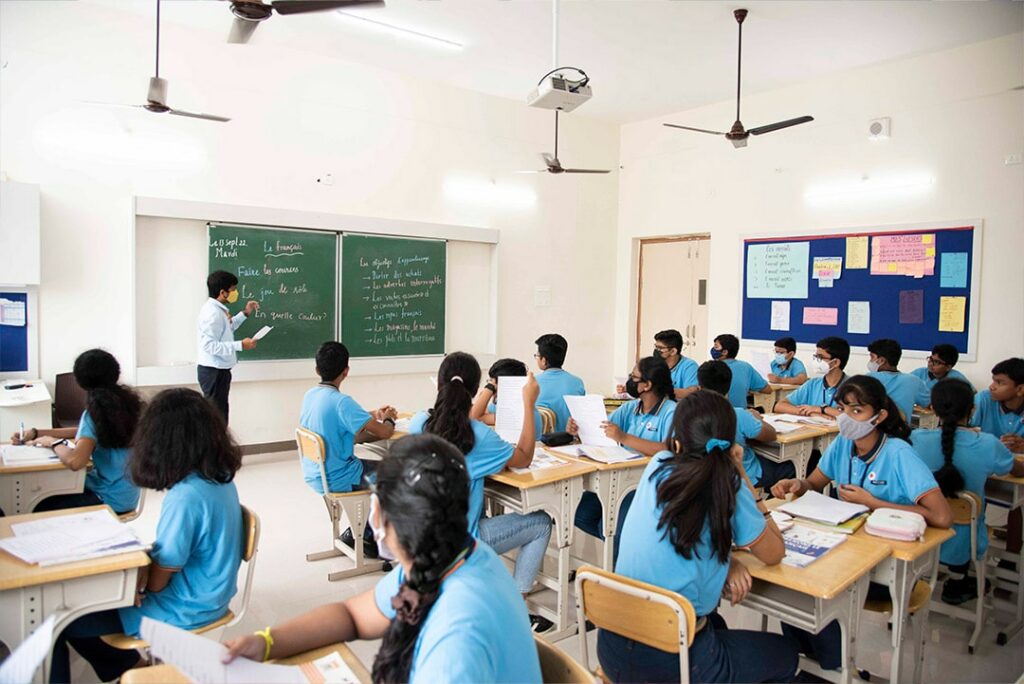
Foreign Language (French)
Learning a non-native language requires skills of a different kind. At Manthan, we develop a set of transferable skills within the curriculum framework to help learners become proficient in the target language faster. These skills allow learners to understand and communicate in everyday situations, in non-native languages, such as French.
The first step is to teach useful key words. Gestures play a key role in the early stages and are used to teach learners how to introduce themselves. Learners are introduced to the vocabulary through gestures, and then shown a contextualised play using the same words. This cements the vocabulary while demonstrating how to use it, which often encourages them to use their own imagination and creativity in order to expand on the learning.
While teaching grammar, new points are introduced as a test to see if learners can work out what the structure means and how it is formed on their own, before the teacher steps in to explain. Learners are encouraged to develop independent learning techniques which will aid their own memorising. Role play of any real-life (or fictional!) situation is often done in class as it is a fantastic way to get students to speak in a non-native language. This allows them to communicate in French by using the relevant vocabulary and convey their feelings, ideas and thoughts. Task-based activities are set in order to create a kind of language immersion. Learners work in small groups and are given a project or task to complete. The teacher acts as a facilitator and observes how well they work in pairs or groups to complete the tasks.
The aim of teaching any foreign language is to achieve proficiency in the four competencies in language studies – listening, speaking, reading and writing. We use listening and reading activities to model good language. Songs and music are useful resources in language teaching and can be applied in teaching any aspect of a language. Singing also acts as an aid to correct pronunciation. It provides a great deal of repetition of sound patterns through the lyrics and also fixes the words and patterns in the mind of the learners. Learners get lots of opportunities to practice orally, both in structured environments led by the teachers, and through free communication with other learners which allows them to repeat and recycle the language as much as possible. They get immediate feedback in class so that they can note down any extra information they might need to improve their skills. They also have opportunities to write in French on familiar, everyday topics, and to speak the language by taking part in everyday conversations.
Such a gradual approach to teaching non-native languages allows leaners to acquire the essential linguistic skills required for progression to further studies or employment. It also encourages learners to be:
Confident
They use new and familiar structures and vocabulary to communicate with others in everyday situations
Responsible
They seek opportunities to use and develop their language skills
Reflective
They consider how to communicate different ideas and attitudes
Innovative
They apply language to a variety of situations and develop learning strategies which help them to express their ideas and their understanding of other cultures

